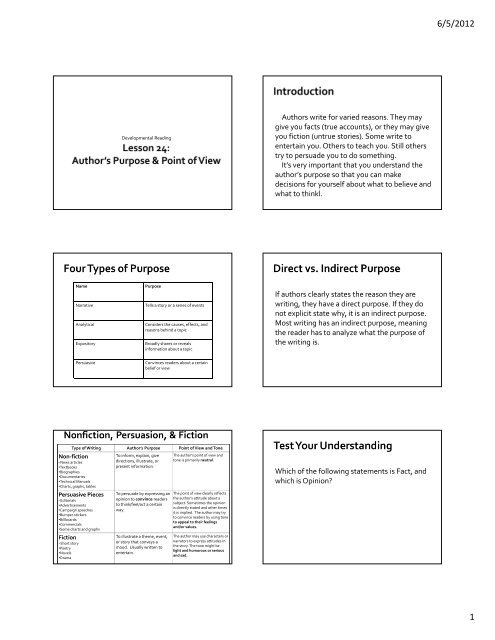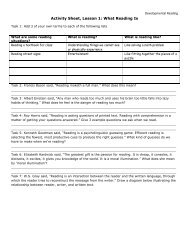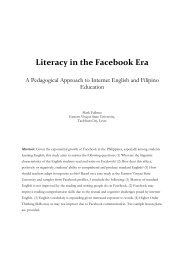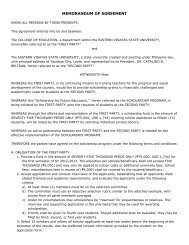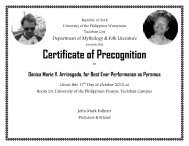PDF handout of the 32 Powerpoints - Mark Fullmer
PDF handout of the 32 Powerpoints - Mark Fullmer
PDF handout of the 32 Powerpoints - Mark Fullmer
You also want an ePaper? Increase the reach of your titles
YUMPU automatically turns print PDFs into web optimized ePapers that Google loves.
6/5/2012Developmental ReadingAuthors write for varied reasons. They maygive you facts (true accounts), or <strong>the</strong>y may giveyou fiction (untrue stories). Some write toentertain you. O<strong>the</strong>rs to teach you. Still o<strong>the</strong>rstry to persuade you to do something.It’s very important that you understand <strong>the</strong>author’s purpose so that you can makedecisions for yourself about what to believe andwhat to thinkl.NameNarrativeAnalyticalExpositoryPurposeTells a story or a series <strong>of</strong> eventsConsiders <strong>the</strong> causes, effects, andreasons behind a topicBroadly shares or revealsinformation about a topicIf authors clearly states <strong>the</strong> reason <strong>the</strong>y arewriting, <strong>the</strong>y have a direct purpose. If <strong>the</strong>y donot explicit state why, it is an indirect purpose.Most writing has an indirect purpose, meaning<strong>the</strong> reader has to analyze what <strong>the</strong> purpose <strong>of</strong><strong>the</strong> writing is.PersuasiveConvinces readers about a certainbelief or viewType <strong>of</strong> Writing Author’s Purpose Point <strong>of</strong> View and ToneNon-fiction• News articles•Textbooks•Biographies•Documentaries•Technical Manuals•Charts, graphs, tablesPersuasive Pieces• Editorials•Advertisements•Campaign speeches•Bumper stickers•Billboards•Commercials•Some charts and graphsFiction• Short story•Poetry•Novels•DramaTo inform, explain, givedirections, illustrate, orpresent information.To persuade by expressing anopinion to convince readersto think/feel/act a certainway.To illustrate a <strong>the</strong>me, event,or story that conveys amood. Usually written toentertain.The author’s point <strong>of</strong> view andtone is primarily neutral.The point <strong>of</strong> view clearly reflects<strong>the</strong> author’s attitude about asubject. Sometimes <strong>the</strong> opinionis directly stated and o<strong>the</strong>r timesit is implied. The author may tryto convince readers by using toneto appeal to <strong>the</strong>ir feelingsand/or values.The author may use characters ornarrators to express attitudes in<strong>the</strong> story. The tone might belight and humorous or seriousand sad.Which <strong>of</strong> <strong>the</strong> following statements is Fact, andwhich is Opinion?1


